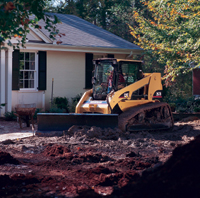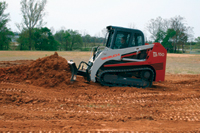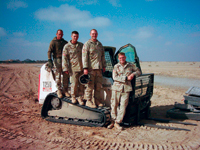Dozer Duties
When spring arrives every year, nature is given the opportunity to start anew. Massive skeletal trees that were once bare from fall begin to spur shades of green. The ground, once a blanket of cold white snow, turns into lush emerald grass and flower beds surrounded by rocks and brown turf bloom with budding foliage.
While trees will regain their shrubbery naturally, other surfaces may require the special attention of landscape professionals to restore the mangled grounds and plants that winter ravaged. As landscapers prepare to tackle winter’s leftovers, a clean slate needs to be created — a level working ground is necessary to transform a barren, brown surface into a nature-packed oasis.
To help create this plateau, these green-thumbed experts call upon compact track loaders and dozer blades to provide a finished grade and help sculpt their visions of bountiful plants and lawns. A compact track loader (CTL) offers traction to perform tough jobs on multiple types of surfaces. With rubber tracks and a light footprint, the loader has the ability to move about a jobsite with minimum damage to the ground. The traction and flotation of the loader allows the operator to produce a level surface and even grade — a must for a lavish, landscape project.
The CTL’s smaller size permits easy transportation between jobs and the ability to work on smaller jobsites, says David Steger, Takeuchi national product manager. The machine’s lighter weight is ideal for hauling it from jobsite to jobsite by using a traditional truck and trailer, rather than a heavier and larger vehicle and trailer that may require a commercial driver’s license (CDL).
When paired with a dozer blade attachment, the CTL can perform applications that involve finished grading, as required in landscaping and site prep work. Since the blade can be angled in different directions, the dirt or material that is being moved can be shifted around to create shapes that a bucket attachment could not. The machine’s light-weight design and traction are ideal for moving about a jobsite with ease and giving dozing applications that extra push that skid steers cannot.
“In landscaping situations where an operator may have to go across a lawn or driveway, a track loader is much more gentle to the surface,” explains Brad Lemke, director of product development for ASV. “You can also move a lot in a hurry because the machine is more nimble, turns quicker and has faster cycle times.”
Building and filling septic tank mounds, moving sand and gravel and creating trenches are also some unique jobs where track loaders and dozer blades can offer assistance, says Kelly Moore, product manager for skid loaders and track loaders at Gehl Co.
Before a landscaper or any other construction professional can utilize the tough combination of a CTL and dozer blade, they must first learn how to pair the two pieces of equipment properly and operate them efficiently.
Dozing Designation

The six-way dozer blade is a versatile, steel push, plow and scrape implement. This attachment can be positioned six different ways through using the controls located inside the CTL’s cab. Steger describes the six functions of the blade as follows: 1 and 2) angle, where the blade is level with the ground and the edges move toward or away from the machine to form a windrow of material; 3 and 4) tilt, in which the edges of the blade move up or down to create slopes; and 5 and 6) up and down.
In order to determine the right blade for a loader, the type of application should be considered in the decision-making process. Moore suggests that an operator should be certain of the type of work he or she’s doing, how many jobs are required and how large those jobs are — this will help determine what size blade may be needed to handle the obligations of the project.
Dozer blades come in a variety of widths, ranging from 72 to 96 in. The size of the blade and loader should be in accordance with one another; for example, a 72-in. blade would be best paired with a smaller loader such as the Gehl model CTL 60, says Moore.
Steger adds that the Takeuchi TL130 would also work well with a 72-in. blade, since the blade should be slightly wider than the machine. The track type and machine horsepower must be taken into consideration as well.
By coupling the blade and loader correctly, the operator and crew will experience more efficiency from both the track loader and its blade. Steger mentions that the width of the blade selected should be just wide enough to cover the machine width at full angle. If the blade that’s selected is too wide, the machine may become overloaded and its production will suffer since the machine may not have enough horsepower, traction or weight to operate the implement.
The durability of the blade is also important. Lemke notes that the strength of the blade and loader should be in accordance with the projects at hand. For example, if an operator plans to use the blade for lighter duty projects like pushing snow or gravel, a light-duty blade would be ideal. However, if the blade is expected to push around a lot of dirt or for stump removal, a heavy-duty blade is best. While a heavy-duty blade may be more expensive, less service stops and problems will make up the difference in cost.
Steger also points out other important considerations to look for when purchasing a blade, which include replaceable cutting edges with replaceable end bits, quality assembly (cylinders, welds and components), ease of operation, visibility and product support after the sale. Six-way dozer blades typically cost around $4,500 to $5,000.
If an operator doesn’t feel a dozer blade is the right choice for his or her compact track loader, a heavy-duty bucket with a hydraulic tilt attachment is also a popular choice among contractors. This pairing uses the weight of the material to keep the front of the loader firmly on the ground and the tracks engaged to the surface, resulting in a better finished grade.
“Some operators prefer to use the hydraulic tilt attachment with a 4-in-1 bucket, giving them the ability to use the moldboard as a dozer or grader, but still maintain the versatility of the bucket to move material,” says Steger.
Other dozing attachment options include a scraper attachment, motor grader attachment and a box blade style land plane.
Practice Makes Perfect

To acquire the experience necessary for properly using a loader with a blade, Steger suggests that an operator spend time maneuvering the loader and attachment on a non-critical job, where he or she will have more time to develop and hone their skills.
Steger adds: “Don’t assume that you will be proficient within the first five minutes. Like everything, it takes practice to develop the control of an experienced operator.”
Slight adjustments in the operator’s cab can also aid in dozing work. Steger mentions that some operators find it beneficial to raise the seat and move it forward to enhance visibility, while maintaining comfort.
In addition, Steger points out that a larger machine is better for dozing applications due to the higher horsepower, weight of the unit and available traction, but the job will dictate the size of the machine that is best suited for the application.
Lemke also suggests positioning the CTL’s arms down while in use for better performance. “By keeping the arms down, you’re transmitting the force of the work to the chassis or frame of the machine and creating less stress on the arms,” he says. “Through doing this, it keeps the machine from wanting to lift from the ground and act more like a dedicated dozer.”
By experimenting with a CTL and dozer blade, an operator can discover the best way to use the equipment, whether it’s for creating trenches or establishing a blank canvas ideal for a landscaper’s work of art.
Pam Stask is assistant editor of Compact Equipment, based in Peninsula, Ohio.
Plow Through Maintenance
Like any piece of equipment, a dozer blade requires a particular
maintenance regimen to stay on top of its game. To best understand the
necessary checks and maintenance routines, operators should become
familiar with the attachment’s operator’s manual.
Before
every use, the blade should be inspected to ensure it’s not damaged and
that it’s properly attached to the loader. The hydraulic hoses,
cylinders and connectors should be visually inspected for leaks. If a
leak is present, it should be repaired immediately to prevent
contamination of the area and the machine’s hydraulic system. Like any
attachment, the pivot points should also be greased according to the
manufacturer’s specifications.
The
blade’s replaceable cutting edge should be checked to ensure that it is
not excessively worn. Extremely worn edges can cause structural damage
to the unit, if worn beyond the useful limit, and will also affect the
overall grade.
Call of Duty

only ones taking advantage of the versatility and efficiency compact
track loaders have to offer. Now, the men and women of the United
States military branches are reaping the benefits of these durable
machines.
Mike Melroe, Bobcat
government sales manager, explains that the addition of compact track
loaders to the military was a natural one. Military personnel saw the
advantages of compact track loaders such as low ground pressure,
increased traction and flotation and the ability to lift heavy loads,
making the machines an ideal fit for everyday duties.
When
it comes to the design and construction of military track loaders,
there are no differences between them and the commercial compact track
loaders that roll off of Bobcat’s assembly line. This not only allows
the military to choose the appropriate loader from Bobcat’s six
different models, but also makes repairs easier down the road.
“Going
with a commercial, off-the-shelf item, in lieu of a specialty-built
product, makes it easier to obtain parts and service for the loaders at
Bobcat dealerships around the world,” says Melroe.
Every
branch of the military uses Bobcat loaders in various applications such
as construction and demolition. “Bobcat loaders have been used for
everything from cleaning airfields of debris to clearing out buildings
for tactical operations centers,” says Melroe. “In addition, the
loaders can be used for hauling rock to projects, clearing airfield
hangars, transporting equipment, digging fighting positions and
constructing protection around base camps.”

Comments are closed here.